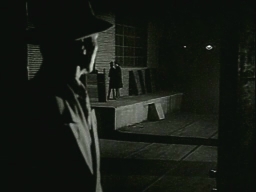
T-MEN 92 min Eagle Lion Films
Two US treasury agents go undercover in LA and Detroit to infiltrate a counterfeiting operation.
Director Anthony Mann
Cinematography John Alton
Screenplay John C. Higgins (Raw Deal, He Walked by Night, Border Incident, Railroaded, Shield for Murder)
Story Virginia Kellogg (Caged, White Heat)
Starring Dennis O’Keefe, Alfred Ryder, Charles McGraw, Wally Ford, Mary Meade, June Lockhart
“Each shot with it’s distortions of space and unpredictable, dissonant lighting, forces an awareness of the visual narrative so that the jingoism of the Treasury Department may be ignored and a vision of the noir underworld may emerge.”
– Blake Lucas in Film Noir: An Encyclopedic Reference (1992)
“effortlessly transcends its semi-documentary brief (with blandly ‘official’ commentary) to land deep in noir territory, concerned less with the heroic exploits of its T-Men than with personality perversities involved in undercover work (the wrenching imperative to deny friends, wives, feelings, even to the point of standing by while a partner is cold-bloodedly executed). John Alton’s superlative camerawork counterpoints tensions and perspectives with almost geometrical precision.”
– T.M. in the Time Out Film Guide
Director Anthony Mann and cinematographer John Alton transform a police procedural screenplay into a dark visionary descent into a subterranean noir realm, where two undercover cops inhabit a flip-side life of criminality, brutality, and violence. These men exist almost exclusively as ciphers whose lives have meaning only in the dark seething undertow of a sinister metropolis. So immersed are these men, that the dying words of one are cheap remonstrations of deceit, and the final vengeful shootout delivers a duel to the death. Add to the mix, stand-out performances by Dennis O’Keefe as the T-man O’Brien, Wally Ford as a doomed hood who carries the richly redolent moniker of ‘the Schemer’, and Charles McGraw as the ruthless hit-man ‘Moxie’, and you have a top-flight thriller.


Every scene in this movie is a set-piece where the mis-en-scene, the lighting, and the camera’s fluid peregrinations in an electric fusion of a chiaroscuro aesthetic and technical mastery, draw the viewer into a hyper-reality of grim tension, dark tenements, hellish steam baths, desolate streets, seedy nightclubs, drab wharves, rusting cargo steamers, sinister business offices, and the decadent palatial homes of mobsters. This nether world is rotten to the core – each time a boss is uncovered yet another further up the social scale surfaces.
Only a touch of pathos is allowed when one of the T-Men and his wife have to deny their identities and feign being strangers, and even this scene telegraphs the cop’s fate as we leave the wife with the glint of a tear in her estranged eyes.


One of the classic noirs – not to be missed.

I think William Friedkin’s CRUISING had some indebtedness to this film, although the thrust of that sordid study ultimately veered in a different direction. Dennis O Brien’s famous line about spending nights in a Turkish bath house certainly made it’s point. The stunning cinematography of this film was featured in the documentary VISIONS OF LIGHT in the early 90’s, and deservedly so.
Excellent choices of reference there with the Blake Lucas and TIME OUT, and one of your greatest paragraphs of all your reviews with this:
“Every scene in this movie is a set-piece where the mis-en-scene, the lighting, and the camera’s fluid peregrinations in an electric fusion of a chiaroscuro aesthetic and technical mastery, draw the viewer into a hyper-reality of grim tension, dark tenements, hellish steam baths, desolate streets, seedy nightclubs, drab wharves, rusting cargo steamers, sinister business offices, and the decadent palatial homes of mobsters. This nether world is rotten to the core – each time a boss is uncovered yet another further up the social scale surfaces….”
And you modestly say you aren’t a film noir expert? Ha! Where will you find better insights, written this brilliantly?
I do like this Mann film by the way, as if you didn’t already know that. I love that documentary feel, for one, but the acting and script are all excellent too. The cinematography? Well, I won’t say more there.
LikeLike
“effortlessly transcends its semi-documentary brief (with blandly ‘official’ commentary) to land deep in noir territory, concerned less with the heroic exploits of its T-Men than with personality perversities involved in undercover work (the wrenching imperative to deny friends, wives, feelings, even to the point of standing by while a partner is cold-bloodedly executed). John Alton’s superlative camerawork counterpoints tensions and perspectives with almost geometrical precision.”
– T.M. in the Time Out Film Guide
The above comment is revealing the world of Noir as depicted repeatedly. Heroic exploits? Not hardly in a vapid meaningless canvas that Noir paints. The mood, the very atmosphere evoked by photography evoke a perverse world the flipside of the American dream as I have read in an essay defining Noir.
LikeLike
Thanks Sam and Edward for your great contributions here! You have both amplified and expanded on my efforts with real wit and authority.
LikeLike
Perhaps the one aspect of the film I wasn’t all that keen on was the sustained narration, which was unecessary, methinks.
LikeLike